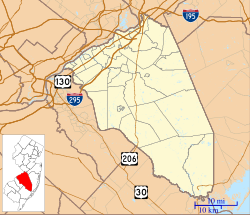
Joseph Wharton was an American industrialist. He was involved in mining, manufacturing, and education. He founded the Wharton School at the University of Pennsylvania, co-founded the Bethlehem Steel company, and was one of the founders of Swarthmore College.

The New Jersey Pine Barrens, also known as the Pinelands or simply the Pines, is the largest remaining example of the Atlantic coastal pine barrens ecosystem, stretching across more than seven counties of New Jersey. Two other large, contiguous examples of this ecosystem remain in the northeastern United States: the Long Island Central Pine Barrens and the Massachusetts Coastal Pine Barrens. The name pine barrens refers to the area's sandy, acidic, nutrient-poor soil. Although European settlers could not cultivate their familiar crops there, the unique ecology of the Pine Barrens supports a diverse spectrum of plant life, including orchids and carnivorous plants. The area is also notable for its populations of rare pygmy pitch pines and other plant species that depend on the frequent fires of the Pine Barrens to reproduce. The sand that composes much of the area's soil is referred to by the locals as sugar sand.

Wharton State Forest is the largest state forest in the U.S. state of New Jersey. It is the largest single tract of land in the state park system of New Jersey, encompassing approximately 122,880 acres (497.3 km2) of the Pinelands northeast of Hammonton. Its protected acreage is divided between Burlington, Camden, and Atlantic counties. The entire forest is located within the Atlantic coastal pine barrens ecoregion as well as the New Jersey Pinelands National Reserve. The forest is located in the forested watershed of the Mullica River, which drains the central Pinelands region into the Great Bay. The forest is under the jurisdiction of the New Jersey Division of Parks and Forestry.

Jack E. Boucher was an American photographer for the National Park Service for more than 40 years beginning in 1958. He served as the Chief Photographer for the Historic American Buildings Survey (HABS). In 1966 he left the Park Service for two years to supervise New Jersey's State Historic Preservation program, including the State's roadside marker program, 18 historic museum houses, several lighthouses, and two historic villages. Offered his old job back by the Park Service/HABS in 1970, he left New Jersey to return to NPS/HABS and the highly specialized job of large format photographic architectural documentation. His work took him to 49 States, the Virgin Islands and Puerto Rico. April 2008 was the fiftieth anniversary of his employment with the National Park Service's "HABS" program. He traveled with 900 pounds of photographic equipment.

Saugus Iron Works National Historic Site is a National Historic Site about 10 miles northeast of Downtown Boston in Saugus, Massachusetts. It is the site of the first integrated ironworks in North America, founded by John Winthrop the Younger and in operation between 1646 and approximately 1670. It includes the reconstructed blast furnace, forge, rolling mill, shear, slitter and a quarter-ton trip hammer.
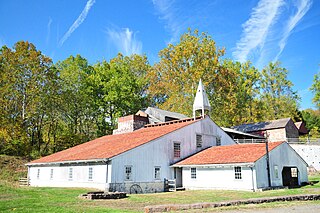
Hopewell Furnace National Historic Site in southeastern Berks County, near Elverson, Pennsylvania, is an example of an American 19th century rural iron plantation, whose operations were based around a charcoal-fired cold-blast iron blast furnace. The significant restored structures include the furnace group (blast furnace, water wheel, blast machinery, cast house and charcoal house), as well as the ironmaster's house, a company store, the blacksmith's shop, a barn and several worker's houses.
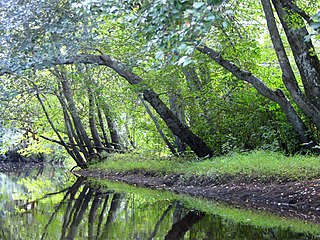
The Batsto River is a 22.9-mile-long (36.9 km) tributary of the Mullica River in the southern New Jersey Pine Barrens in the United States. The river also drains 49.42 square miles of land.
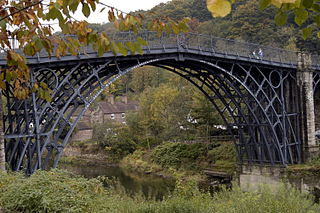
An ironmaster is the manager, and usually owner, of a forge or blast furnace for the processing of iron. It is a term mainly associated with the period of the Industrial Revolution, especially in Great Britain.

Greenwood Furnace State Park is a 423-acre (171 ha) Pennsylvania state park in Jackson Township, Huntingdon County, Pennsylvania in the United States. The park is near the historic iron making center of Greenwood Furnace. The park includes the ghost town of Greenwood that grew up around the ironworks, old roads and charcoal hearths. Greenwood Furnace State Park is adjacent to Rothrock State Forest and on the western edge of an area of Central Pennsylvania known as the Seven Mountains. The park is on Pennsylvania Route 305, 20 miles (32 km) south of State College.
Mount Hope is an unincorporated community and census-designated place (CDP) that is a part of Rockaway Township in Morris County, New Jersey, United States. As of the 2020 United States census, the population was 2,930.
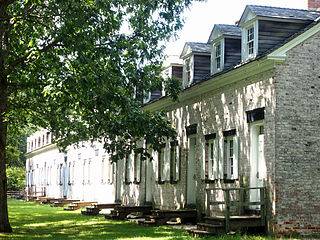
Allaire Village is a living history museum located within New Jersey's Allaire State Park in Wall Township, Monmouth County, New Jersey. The property was initially an Indian ceremonial ground prior to 1650, by 1750 a sawmill had been established on the property by Issac Palmer. The village was later established as a bog iron furnace originally known as Williamsburg Forge 'Monmouth Furnace' was then renamed the Howell Works by Benjamin B. Howell. In 1822, it was then purchased by philanthropist James P. Allaire, who endeavoured to turn into a self-contained community. The wood burning furnace business collapsed in 1846 and the village closed. During its height, the town supported about 500 people. Following his death, the property passed through a number of family members before being used by the Boy Scouts who started to restore the buildings for use as a summer camp. Losing the lease, the property then passed to the State of New Jersey. Allaire Village and its existing buildings are now operated by a non-profit organization - Allaire Village, Inc. Historic interpreters work using period tools and equipment in the blacksmith, tinsmith, and carpentry shops, while the old bakery sells cookies, and general store serves as a museum gift-shop styled store. The church building is frequently used for weddings. The village relies heavily on volunteers to provide historical interpretation and to model historic crafts for the visitors. The site is also host to community events such as community band concerts, antique sales, weekly flea markets and square dance competitions.

Howell Works was a bog iron-based production facility for pig iron which was established in New Jersey in the early 19th century by American engineer and philanthropist James P. Allaire. It is notable as one of the earliest American examples of a company town.

Atsion Lake is a man-made lake in Wharton State Forest in the Pine Barrens, in the community of Atsion, Burlington County, New Jersey. The lake is part of the Mullica River. It offers boating, hiking, fishing, swimming and camping facilities, and cross-country skiing in the winter.

The Batona Trail is a 53.5-mile (86.1 km) hiking trail through New Jersey's Pine Barrens. The trail is one of the longest in the state, behind the Delaware and Raritan Canal Trail, the section of the Appalachian Trail within the state, the Liberty-Water Gap Trail, and the completed section of the Highlands Trail in the state. The Batona Trail begins in Brendan T. Byrne State Forest at the ghost town of Ong's Hat and traverses Franklin Parker Preserve, Wharton State Forest and Bass River State Forest. The trail was built in 1961 by the Batona Hiking Club, which began informally in 1928 when Philadelphians began meeting regularly to hike. It takes about three days to hike the whole trail.
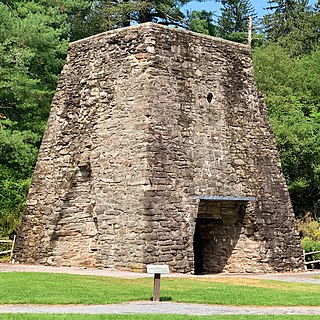
The Pine Grove Iron Works was a smelting facility in southcentral Pennsylvania during the Industrial Revolution. The works is notable for remaining structures that are historical visitor attractions of Pine Grove Furnace State Park, including the furnace stack of the Pine Grove Furnace. The site was listed on the National Register of Historic Places on April 13, 1977 for its significance in architecture and industry. It includes seven contributing buildings, two structures, fourteen sites, and two objects.

Atsion is an unincorporated community located within Shamong Township in Burlington County, in the U.S. state of New Jersey. The community is located next to Atsion Lake.

The Swatara Furnace is a historic iron furnace and 200-acre national historic district located along Mill Creek, a tributary of the Swatara Creek in Pine Grove Township, Schuylkill County, Pennsylvania.

Pleasant Valley is an unincorporated community located within Marlboro Township in Monmouth County, in the U.S. state of New Jersey. The area reportedly received its name from George Washington after he went through the area in 1777. The area is hilly and forested and is dotted by medium to large-sized residences. Pleasant Valley Road and Reids Hill Road are main roads that pass through the area connecting to Routes 34, 79, and 520. A large part of land which makes up Pleasant Valley was originally granted by the King of England in 1665 to the Rev. Obadiah Holmes. In 1690, the area was settled by people of Dutch heritage and the original dominant language in the area was Low Dutch.
Martha Furnace is an abandoned iron furnace in Burlington County, New Jersey, in the New Jersey Pine Barrens. It operated between 1793 and the mid-1840s, using charcoal fuel and locally-mined bog iron to make a variety of cast products as well as pig iron. For most of its operating history, it was principally owned by the New Jersey ironmaster Samuel Richards and managed by Jesse Evans. The settlement that grew up around it was abandoned after ironmaking ceased, and the site of the furnace now lies undeveloped in Wharton State Forest.

Samuel Richards was an American businessman and ironmaster. He was heavily involved in the New Jersey iron industry during the early 19th century, starting with his family's iron business in Batsto Village, New Jersey, where he apprenticed under his father, William Richards. Richards would eventually come into ownership of Weymouth Furnace and Martha Furnace in 1808, in addition to the Atsion Iron Works in 1822. His half brother, Benjamin Wood Richards, became mayor of Philadelphia.

